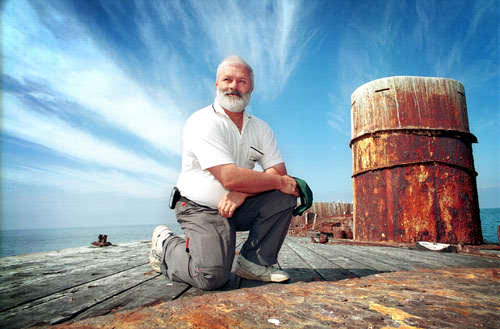|
Time to save Cerberus By DEREK BALLANTINE 04jan04 YOU can look at Cerberus and see a rusting hulk. You can look at Cerberus and see history, frozen in time and in the waters she protected with her big guns a century ago. You can look at Cerberus and see scrap that must be cleared from the shoreline, but better to look at Cerberus and see a relic worth saving.
Whichever way you look at Victoria's first warship, a tragic mockery of the pioneering spirit she once represented, make it quick. HMVS Cerberus, launched in 1868, the first British warship without sails, guardian of Port Phillip Bay and Victoria's Gold Rush prosperity, is close to extinction. The iron and timber veteran of Victoria's colonial navy is one storm away from total collapse at her final resting place in Half Moon Bay, Black Rock. So unstable is her condition that a new alliance of business people, heritage buffs, maritime historians and archeologists has been formed to throw a lifeline to a vessel that traces her lineage to the American Civil War. "It is our last chance," says history enthusiast Gary Grimmer, chief executive officer of the Melbourne Convention and Visitors Bureau. An engineering report on Cerberus has sounded the warning that time is running out. Having suffered major damage in a 1993 storm, plunging her main deck under water, the weight of her mighty iron upper works is taking its toll on rotting timbers below the surface. Cerberus will soon be beyond rescue. "Many people don't see past the rusting metal. If people understood how important she was in world history, things would be different," says John Toogood, newly elected chairman of Friends of the Cerberus. Cerberus was an engineering marvel in her day. Built after the success of the first iron-clad warship, Monitor, in the war between Union and Confederate forces in America in the 1860s, Cerberus was one of the first vessels to use the Suez Canal. She was flagship of the Victorian Navy before Federation, guarding Port Phillip as a Royal Australian Navy gunship in World War I.
She was at the cutting edge of naval technology, capable of making herself a small target by fighting semi-submerged, her two rotating gun turrets packing a tremendous punch. She preceded the mighty dreadnoughts, which in turn gave way to fast battleships, which in turn gave way to the missile platforms of today's navies. "There was a time when the whole world knew about the famous Cerberus," Mr Toogood says. The US appreciates the value of maritime history -- it spent $20 million saving the engine and a gun turret from the sunken Monitor and is building a museum for them. Australia is fortunate Cerberus, unlike its American ancestor, remains accessible on the inshore sandbar on which it was scuttled in 1926. There has been no shortage of restoration plans over the years, but all have foundered for lack of money and support of governments. With time running out, the new group wants to stimulate interest in a plan to lift the ship on to an underwater cradle so that the heavy iron superstructure can be preserved. It wants to restore the gun turrets, the barrels of which are still on board. At least $5 million is needed -- which Mr Grimmer describes as a small price to pay for a unique piece of our history. Membership of Friends of the Cerberus costs $20 a year. Contact Peter Tully, secretary, PO Box 1231, Blackburn North, 3130; or at website www.cerberus.com.au
|


